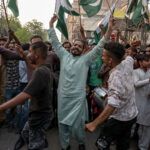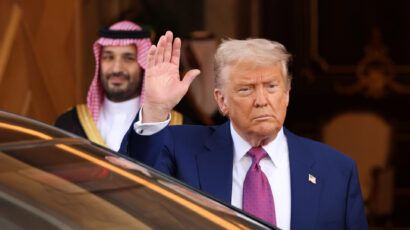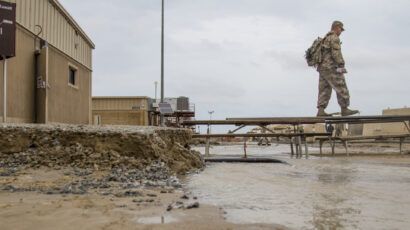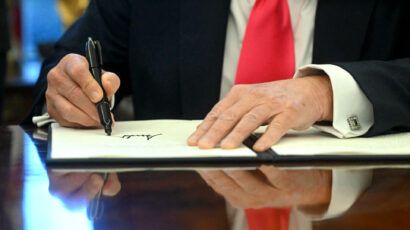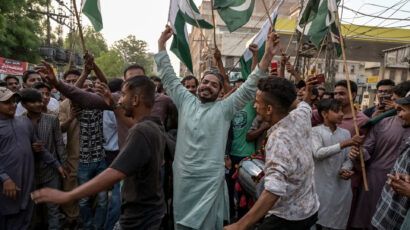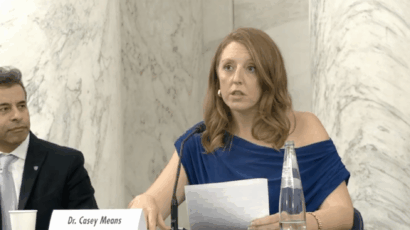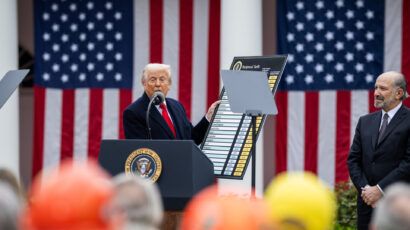Will killing of Iran’s Soleimani influence North Korea’s “strategic weapon” plans?
By Duyeon Kim | January 9, 2020
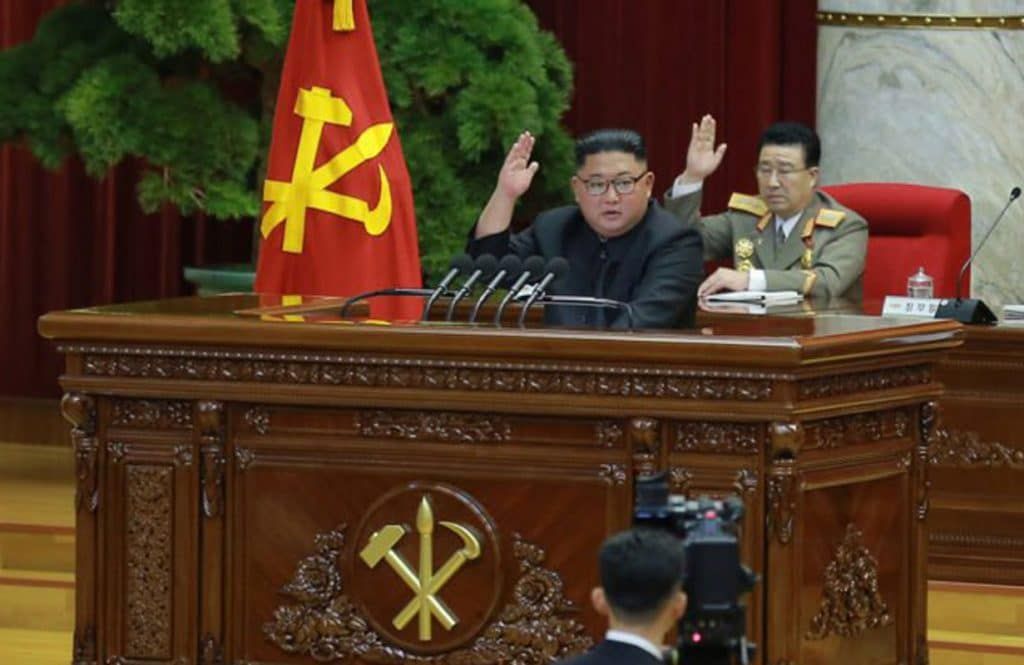 Kim Jong Un, giving his plenary speech. Photo credit: KCNA
Kim Jong Un, giving his plenary speech. Photo credit: KCNA
It’s anybody’s guess as to what North Korean leader Kim Jong Un is thinking and feeling in reaction to the US killing of General Qasem Soleimani, head of the Iran’s Quds Force. In Kim’s mind, does the killing make it seem less likely that US President Donald Trump’s “fire and fury” rhetoric and escalatory actions of 2017 were a bluff? Does the regime regard Soleimani’s death as a warning not to provoke Washington this year with more weapons tests? Will Pyongyang be more cautious this year than in the past, or will it see Washington’s preoccupation with the Middle East as an opportunity to accelerate perfecting (including testing) its nuclear weapons capability? Will the killing further confirm in the North Korean leader’s eyes his rationale of having nuclear weapons to guard against what he views as US aggression?
Whatever Kim thinks and does, it will be against the backdrop of a newly-minted plan of action for this year that is contained in a report released after a rare, marathon plenary meeting on December 28-31 of the Workers’ Party’s Central Committee. At the gathering, Kim, as reported by North Korean state media, declared an end to his moratoria on testing nuclear devices and long-range missiles and warned the world that it would see a “new strategic weapon.”
His comments at the plenum took the place of Kim’s usual New Year’s Day address laying out the regime’s domestic and foreign policy plans for the upcoming year. Of course, the regime will likely make tactical adjustments to the plan along the way, depending on how its relationship with Washington and its assessment of the risks created by different courses of action evolve. Still, the roadmap offers useful insights into Kim’s thinking about the year ahead.
A “new strategic weapon” – to test or not to test. The rollout of a “new strategic weapon” could be the testing, showcasing, or deployment of any of many possible weapons or platforms, including an improved inter-continental ballistic missile (ICBM), a submarine-launched ballistic missile, a submarine capable of launching missiles, a satellite launched into orbit, or a more dangerous weapon (perhaps even a thermonuclear one) that is qualitatively new. If it comes in the form of a nuclear warhead or long-range missile test, the United States and many in the broader international community would see it as a grave provocation and more serious violation of UN Security Council Resolutions than the short-range missile tests the North has been conducting in recent months. Kim has indicated that the choice of exactly what type of weapon to test and when to test it would depend on how he perceives the actions of Washington. He told the plenum that “the scope and depth of bolstering our deterrent will be properly coordinated depending on the US future attitude to the DPRK.”
The rollout could be handled in a way less likely to evoke a strong reaction from Washington. If, as an alternative to testing, a “new strategic weapon” is simply put on display, or if Pyongyang declares that it’s been deployed, Pyongyang would still reap political impact (domestically and internationally) and might believe the move would not lead to a harsh response, perhaps even a kinetic one, from Washington.
Kim is likely to choose his course based on whether his “dignity was insulted” (a common phrase and complaint by North Korea), whether he perceives that Trump is hurting their personal relationship, or how “hostile,” as North Korea generally puts it, he perceives the US government to be behaving toward his country. For example, if Trump makes a comment that deeply upsets Pyongyang or if the United States and South Korea resume combined military exercises in March (most of which have been canceled, downsized, or rescheduled since the Trump-Kim Singapore summit in June 2018), Pyongyang might see the situation as justifying a test of an improved ICBM or some other “new strategic weapon.” If, however, the regime felt aggravated but not deeply insulted, it might settle for the display of a “new strategic weapon” or a deployment declaration.
In any case, the regime will likely continue with missile tests and other military demonstrations of its capability below Trump’s stated threshold of long-range missiles and nuclear devices.
Tightening belts in 2020. Warning of a “long confrontation with the US” and stressing the need to “tighten our belts” in North Korea’s “revolution” to “defeat imperialism,” Kim conveyed his overarching objective as doubling down on both nuclear and economic development. This means a revitalization of the regime’s byungjin strategic line (conceptualized in 1962 by his grandfather, Kim Il Sung) of developing both objectives in parallel. Contrary to many observers’ interpretation that Kim had ended byungjin in 2018 to focus only on economic development, byungjin never left the picture. Pyongyang continued to, as Kim has put it, “mass-produce nuclear warheads and ballistic missiles” and test missiles, even though the regime publicly refrained from mentioning byungjin. According to Kim’s latest remarks, North Korea will continue pursuing this strategy until it becomes a “mighty and prosperous nation.”
The way the Party plenum’s report reads, Kim’s message was measured, calculated, and calm. The tone of the documented message did not suggest that Kim was particularly enraged that the United States had not met his year-end deadline to deliver a satisfactory proposal to implement the 2018 Singapore Joint Statement. It did, however, show frustration, particularly in the announcement that Pyongyang would lift its unilateral moratoria on nuclear and long-range missile tests and possess a “new strategic weapon,” decisions that he blamed on the United States, claiming that it had not reciprocated North Korea’s gestures. Kim said, “There is no ground for us to get unilaterally bound to the commitment any longer, the commitment to which there is no opposite party, and this is chilling our efforts for worldwide nuclear disarmament and non-proliferation.”
At the same time, however, Kim left some wiggle room for diplomacy aimed at “denuclearization on the Korean peninsula,” but under the condition that “the US rolls back its hostile policy” (by ending all combined military exercises, sanctions, and criticisms about human rights violations). Perhaps the door has been left ajar—if only a crack—because Trump has so far been conciliatory toward Kim in his public comments.
A “new way” and a bleak future for diplomacy. A year ago, in his 2019 New Year’s Day address, Kim warned that his country would embark on a “new way” (or “new path”) if Washington did not present an acceptable deal to implement the Singapore understanding. His declarations during the December 2019 Party plenum, however, essentially signal a return to the old way of nuclear (and economic) development. They also signal he may be playing hard ball even harder.
Kim seems to be rejecting Washington’s argument that giving up nuclear weapons will lead to economic success. Paired with his warning about possessing a “new strategic weapon,” Kim declared, “we cannot give up the security of our future just for the visible economic results and happiness and comfort in reality.” Kim is apparently implying that nuclear weapons are actually integral to both his country’s survival and its prosperity. This foreshadows an even higher price tag for North Korea’s nuclear weapons if Pyongyang decides to abandon them one day; the price for resuming negotiations might have also jumped. And, Kim seems to be signaling tougher times ahead for diplomacy by saying, “It is true that we urgently need [an] external environment favorable for the economic construction, but we can never sell our dignity which we have so far defended as valuable as our own life, in hope for brilliant transformation.”
Trump has publicly downplayed Kim’s latest threats, saying, “He did sign an agreement talking about denuclearization… I think he’s a man of his word, so we’re going to find out.” But it would not be a surprise if the killing of Soleimani has given Kim another reason for reluctance to abandon his nuclear weapons, even if it causes Kim to exercise restraint in the near term.
Skipping the New Year’s Day address. Although it is unusual for Kim not to deliver a New Year’s Day address, his comments during the plenum can be regarded as his plan for 2020. It is rare but not unprecedented for a Kim dynasty leader to skip a message on January 1. Kim Jong Un’s grandfather, Kim Il Sung, usually delivered a New Year’s Day address in his own voice from 1946 to 1994, although he skipped it in 1957 and 1987, and the addresses were sometimes given in the form of an editorial in Rodong Sinum (the official newspaper of the Workers’ Party Central Committee). Kim’s father, Kim Jong Il, chose to convey his marching orders from 1995 to 2011 through state-mandated newspaper editorials published jointly by North Korean media outlets. In 2012, there was no address because Kim Jong Il had died in December 2011, so North Korea’s main newspapers released a joint editorial of what they called his “dying injunction.” Then, in 2013, Kim Jong Un started emulating his grandfather by delivering New Year’s Day addresses himself every year.
A North Korean leader’s decision to forgo the new year message might be an indication of harsh times (present or future forecast for the country domestically and in its foreign relations) or a reflection of a decisive moment for the future of the Kim regime. Both circumstances were the case in 1956, when Kim’s grandfather ruled. During the famous 1956 Plenum Incident (“August Faction Incident”), leading North Koreans from the Soviet-Korean faction and the Yonan faction (pro-China communists) attempted to remove Kim from power during the 2nd Plenary Session of the Workers’ Party 3rd Central Committee. Kim Il Sung eliminated his opposition in a dramatic showdown during the plenum, held another plenary meeting in December that year, and did not deliver a New Year’s Day address in 1957.
Fast forwarding 63 years, perhaps Pyongyang truly sees a need to tighten belts this year in its “offensive for [a] frontal breakthrough.” Soleimani’s death might be a new twist in Kim’s plans on a tactical level, proving to him that Trump’s tough talk is not always empty bluster. For now, Pyongyang might be even more cautious than Kim’s reserved new year’s orders suggest when it calculates the scale and timing of its next move as it keeps one eye firmly on how the US-Iran confrontation pans out. North Korea has much to gain from maintaining a low-key profile in the near term: It can continue to advance toward to its nuclear and economic goals without ruffling Trump’s feathers.
Together, we make the world safer.
The Bulletin elevates expert voices above the noise. But as an independent nonprofit organization, our operations depend on the support of readers like you. Help us continue to deliver quality journalism that holds leaders accountable. Your support of our work at any level is important. In return, we promise our coverage will be understandable, influential, vigilant, solution-oriented, and fair-minded. Together we can make a difference.
Keywords: Kim Jong-un
Topics: Columnists, Nuclear Risk, Nuclear Weapons



